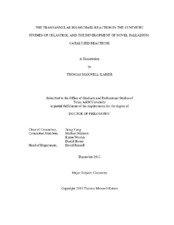| dc.description.abstract | Pharmaceutical R&D is currently undergoing a productivity crisis. Also, the loss of activity of established medicines continues to reduce the pool of agents capable of treating infectious diseases. Small molecule synthesis and synthetic methodology development continue to be essential scientific endeavors due to the ability of synthetic chemistry to create new starting points for the development of medicines. Therefore, in order to increase the ability to discover new medicines, more efficient synthetic strategies and transformations capable of generating structurally complex drug-like molecules are required.
This work explored the transannular bis-Michael reaction (TMR) as a potential method to access polycyclic natural products in an efficient manner. We sought to develop an expedient route to an all-carbon Z,E macrocyclic precursor to the TMR and we then evaluated whether the Z,E isomer would follow our proposed model for the TMR. Our strategy relied on a 1,3-dipolar cycloaddition to access the TMR precursor. However, this 1,3-dipolar synthetic route had a low synthetic efficiency.
Consistent with our other studies, this Z,E-macrocyclic bis-enone was found to be inactive in the transannular bis-Michael reaction cascade for the conditions evaluated. En route, we also discovered that our 1,3-dipolar cycloaddition gave a rare 3,4-disubstituted isoxazole under kinetic reaction conditions. We also demonstrated that the dipolar cycloaddition is reversible and the thermodynamic 3,5-disubstituted isoxazole can be obtained through isomerization of its 3,4-disubstituted isomer under elevated temperature. Our initial mechanistic studies support the role of hydrogen-bonding in accelerating the isomerization process.
Our work in developing new palladium-catalyzed reactions resulted in a novel palladium-catalyzed enamine Heck reaction. This reaction is capable of generating α,β-unsaturated ketones directly from aldehydes and vinyl iodides. However, the limitations of scope in both vinyl iodide and aldehyde severely limit the synthetic utility of the reaction described herein.
Also, our work clearly demonstrated a novel enantioconvergent approach to 3-allyl-3-alykl-indolenines through the use of a chiral palladium/trialkylborane dual catalyst system. We suggest a greater role of trialkyl borane beyond allylic alcohol activation in previous allylation examples employing R_(3)B/allyl alcohol as the allyl source.
Finally, we extended or understanding of the role of Et_(3)B to the Tamaru allylation. The Lewis acid, Et3B, facilitates enolization and behaves as a co-catalyst to effect the allylation of aldehydes. We have also begun developing an enantioselective version of this reaction that suffers from low enantioselectivity. This reaction was shown to be selective for aldehydes as ketones did not react under the described conditions. | en |


